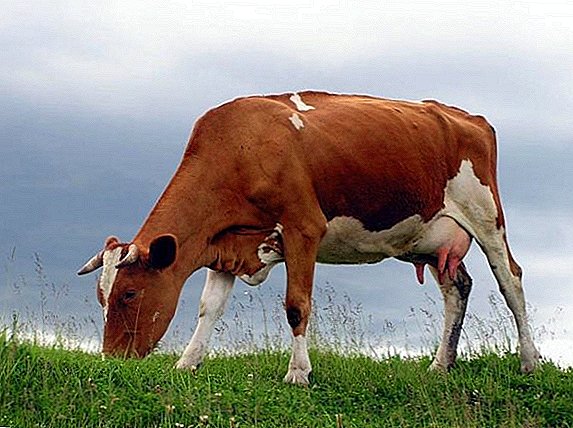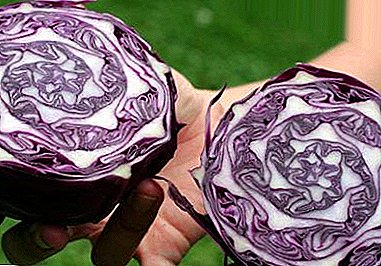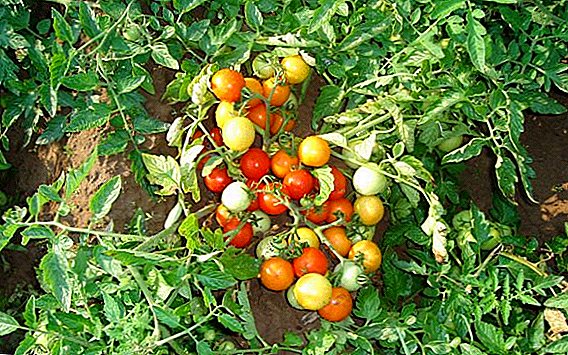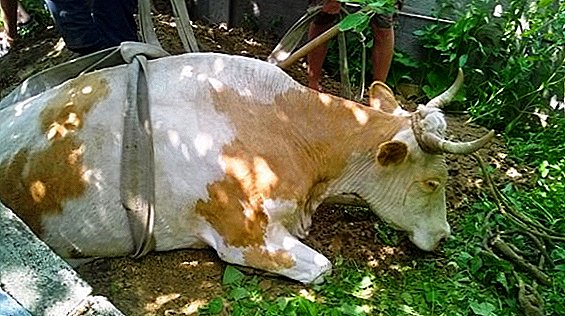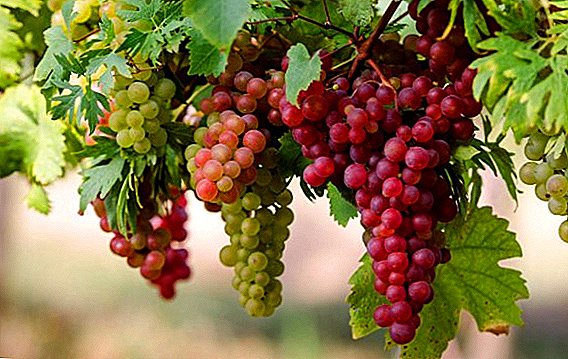 Diseases of grapes - a great threat to this plant. The most sweet and large varieties remain the most susceptible to them, despite the work of breeders. Therefore, in order to get a good harvest, you need to know how to treat grapes for diseases.
Diseases of grapes - a great threat to this plant. The most sweet and large varieties remain the most susceptible to them, despite the work of breeders. Therefore, in order to get a good harvest, you need to know how to treat grapes for diseases.
Did you know? Grapes - the only plant in the world that studies a separate science - ampelography.
Necrosis of wood vessels
This disease most often attacks young seedlings. Externally, it manifests itself in browning and gradual cell death near the vessels of wood. Affected grapes fall behind in growth and become more susceptible to bad weather conditions (drought, strong wind, frost, etc.). The cause of the disease experts believe fungi, which penetrate into the wood during winter storage.  For the prevention and control of the disease it is recommended:
For the prevention and control of the disease it is recommended:
- during the preparation and storage of the vine do not use materials that retain moisture, for example, polyethylene;
- grape queen cells should be only on light soils with good drainage;
- periodically add boric fertilizers to the soil under vegetative plants.
Shrinking shoots
It is not an infection, as it is caused by a metabolic disorder at the base of the bunch. Occurs with heavy rainfall or lack of moisture. The disease develops rapidly. Dotted and oblong spots of brown and black color appear. The lesion covers the deep layers of the shoot.
The fight against drying out is:
- spraying with 0.75% magnesium chloride, 0.75% calcium chloride, or a mixture of these preparations (concentration - 0.5%);
- spraying 3% magnesium sulphate.
Important! For grapes, especially sensitive to drugs, chemical treatment is not suitable. In this case, make complex fertilizers.
Alternaria
One of the most common fungal diseases of grape leaves. Contributes to the defeat of high humidity and heat. First, on the foliage appear light blotches with signs of necrosis in the middle. Then the sheet completely blackens, the mold develops. Berries shrivel, bloom and become tasteless. 
Important! The fight against Alternaria should begin as soon as a couple of first leaves appear on the vine in the spring.
Experts in the case of lesions of the disease with this disease recommend:
- carefully remove the fallen leaves of grapes, dead shoots, bark, etc., since it is in them fungus winters;
- at the beginning of the growing season to process the grapes Bordeaux liquid, then - as necessary, every 10-14 days. You can also use the drugs "Kvadris", "Rapid Gold", "Skor", "Kolfugo Super."
Armillaria
The second name of the fungal disease is root rot. It is characterized by the browning of the roots of grapes, they become loose and soft, the leaves dry. Mushroom can be seen at the base of the bush with the naked eye. The plant dies.  Experts advise:
Experts advise:
- dig ditches between the vineyard and forests and forest plantations to prevent infection by fungal spores;
- destroy diseased plants and treat the soil under them with copper-containing fungicides.
Important! On the infected site, grapes are not planted for at least a year.
Aspergillus rot
Fungal disease of grapes, affecting berries in dry weather. At first, white spots are formed on the berries. Over time, they darken. Places of education become soft, depressed. Then the berries begin to crack, a white bloom appears on them, then - a powdery black-brown mass. The clusters become unsightly black.  The means to combat this and other diseases affecting ripe grapes are the following:
The means to combat this and other diseases affecting ripe grapes are the following:
- quick harvest when ripe, so as not to have time to develop rot;
- careful cleaning of the vegetable remains in which the fungus can remain.
White rot
The cause of the disease is fungus. Usually affects the vineyard in the second half of summer, after the sun or hail. It flows very quickly. In just a few hours, the berries darken and shrink. The main symptom of white rot in dry weather is the appearance of pinkish dots, and in wet weather - black specks. Individual berries, a part of a bunch or the whole bunch can be damaged. Falling on the ground, the affected berries become a breeding ground for the disease.  In order to prevent and combat white rot, the following methods are used:
In order to prevent and combat white rot, the following methods are used:
- be sure to handle the vineyard "Kolfugo Super" or "Fundazol" after hail;
- you cannot take cuttings from diseased bushes for planting;
- Bushes that have had white rot in the past are treated with fungicides 2-3 times per season to prevent re-infection.
Acid rot
The first harbinger of the disease is the appearance of brown rotten berries in normal bunches of grapes. Often, acid rot affects varieties with juicy pulp and thin skin. After a short time, their number increases, the fruit flies begin to fly to the smell of rot.  In identifying the disease is recommended:
In identifying the disease is recommended:
- gently remove all damaged clusters;
- treat the vineyard with an insecticide, for example, "Fitoverm", bordeaux liquid or spray garden sulfur.
Did you know? French scientist Pierre-Marie Alexis Milardé invented Bordeaux liquid specifically to combat fungal diseases of grapes. Nowadays, it is used as a universal fungicide and for other cultures.
Gray rot
It affects the berries, which begin to darken, burst, and then covered with a gray wet bloom. Since there are no effective methods to combat this disease, special attention should be paid to prevention:
- periodically loosen the soil under a bush and destroy weeds;
- time to remove diseased clusters;
- plant grapes at a great distance from each other for sufficient ventilation and warming;
- spray berries 1% solution of baking soda or medical iodine (30-40 drops of iodine dissolved in a bucket of water). The treatment is carried out once every 10 days at the slightest suspicion of gray rot.

Black rot
Fungal disease, which often affects vineyards located near water. Berries gradually shrivel and turn black. At high humidity, wet rot forms, and in dry weather they simply dry out. After dropping on the soil are carriers of the disease. With black rot, light spots with a dark green rim appear on the leaves, and characteristic black stripes appear on the stems. Since the disease is almost not treatable, the fight against it comes down to prevention:
- destruction of diseased berries, stems, leaves;
- uprooting old vineyards.

Bacteriosis
Infection affects grapes during the growing season. Manifested by the appearance of brown and pink spots on the berries, which have a wrinkled structure. In the future, the berries dry up. They provoke the development of the disease sunburn.
For prevention and treatment it is recommended:
- protection of grape plantations from excessive sunlight;
- removal of affected berries;
- fight against insects that destroy the shell of the grapes.

Bacterial cancer
Bacterial infection, the main symptom of which is the formation of tumors under the cortex. After winter frosts, such bubbles burst, disrupting the integrity of the bark.
For the treatment and prevention of bacterial cancer of the grape practiced such methods:
- protection of young shoots from frost;
- avoidance of mechanical damage in any manipulation of the plant;
- timely removal of diseased branches; at this point the cut is treated with a 3% solution of Bordeaux mixture or 5% solution of ferrous sulfate;
- if the disease has already struck the grapes, it is necessary to apply phosphorus-potassium fertilizers, eliminating nitrogen for several years. You can also use wood ash.

Rubella infectious
A fungus infection occurs through any mechanical damage to the leaves and branches. Painful spores are moved to a young plant with weeds and soil. First, wedge-shaped rust-colored spots appear on the sheets, and soon the foliage falls completely. Such plant residues become carriers of the disease.  Prevention and treatment of the disease:
Prevention and treatment of the disease:
- destruction of the affected leaves;
- regular digging of the soil under the bushes and careful pruning of the shoots;
- treatment of wounds on the branches of disinfectants;
- spring spraying of grape leaves with fungicides (Ridomil Gold, Bordeaux mixture, etc.); preparations must be applied both on the upper surface of the leaves and on the lower one;
- mineral fertilization of the soil (eg, potassium nitrate) and organic fertilizers, which increases the resistance of the disease.
Spotted necrosis
Spotted grape necrosis is a fungal disease that is manifested by the appearance of foci of dead tissue under the cortex. The same dark spots are formed over time and on the leaves. Prevention and treatment of the disease are as follows:
- destruction of fallen leaves;
- deep digging of the soil under the plant;
- timely pruning of branches, which provides good ventilation between the shoots;
- storage of planting material in a ventilated area;
- treatment of seedlings with a solution of ferrous sulfate (4%).

Oidium (powdery mildew)
With the defeat of oidium grape leaves are first covered with white bloom with black patches. Soon dark spots appear on the shoots, and the buds fall. Externally, the affected parts of the plant appear as sprinkled with ashes. During the ripening of grapes, the grapes burst, a gray mass with an unpleasant smell follows from them. The impetus for the development of the disease can be hot weather or a sharp change in air temperature.
Spring processing of grapes from oidium is carried out with a solution of colloidal sulfur (1%). It is repeated every 10-12 days until the symptoms of the disease disappear. You can also use specialized drugs "Acrobat MC", "Carbis Top". 
Important! In no case can not take on the propagation of cuttings of affected plants.
Mildew (mildew)
The disease affects all parts of the grapes. It starts with small oily spots on the surface of the leaves, which gradually increase in size. Over time, the leaf becomes brown, dries and falls. The same happens with the affected stems, buds and berries. Most often the disease develops in the second half of spring - the first half of summer.  Protection of grapes from this and similar diseases in nature is:
Protection of grapes from this and similar diseases in nature is:
- burning all the fallen leaves;
- digging around the bush;
- timely pruning of grapes for better ventilation;
- spraying the bushes with copper-containing preparations (Bordeaux mixture, copper oxychloride) in two stages (before flowering and after 14 days). You can use the drugs "Oxyh", "Kurzat", "Hom", "Polyhom".
Septoria
Another name for the disease is melanosis. Characteristic for the nutmeg varieties of culture. At the initial stage of the disease, small brown foci can be seen on the leaves. At high humidity, fluffy mold can also form on the underside of the foliage. Soon it dries and falls, remaining a carrier of the pathogen.
Treat grapes by spraying with a weak solution of Bordeaux mixture. (one%). For the prevention of the disease carefully destroy the fallen leaves and damaged bushes.
Black spot
It affects the aboveground parts of the plant. Symptoms of the disease are:
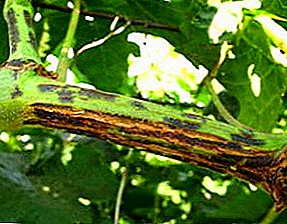 dark brown dots on the leaves, gradually turning into black spots;
dark brown dots on the leaves, gradually turning into black spots;- changing the color of the berries to a darker, unnatural hue, their taste deteriorates;
- development of rot in shoots.
- utilization of plant residues in the fall;
- spraying Bordeaux liquid or "Euparenom" during the growing season.
Chlorosis
Chlorosis of grapes can be both infectious and non-infectious nature. And in fact, and in another case, the plant disrupts the normal process of photosynthesis, because of which the leaves turn pale. The growth of shoots slows down, and the foliage soon dries and falls. The main method of treatment is spraying the bushes with iron-containing preparations, for example, vitriol or Brexil-chelate. The procedure is repeated several times. 
Cercosporosis
In the spring of this fungal disease can damage all aboveground parts of the bush. The source of infection are the remains of diseased plants. At an early stage, cercosporosis is diagnosed by the appearance on the back side of leaves of a plaque of olive color and dark spots, which eventually dry out. Berries harden and shrivel. Soon the grapes and foliage fall. Grape spine is treated by spraying Bordeaux liquid. If the grapes are of no special value, they are uprooted.
Most diseases of the grapes can be avoided by carefully removing plant residues after harvesting and applying preventive treatment of grapes with fungicides.


 dark brown dots on the leaves, gradually turning into black spots;
dark brown dots on the leaves, gradually turning into black spots;